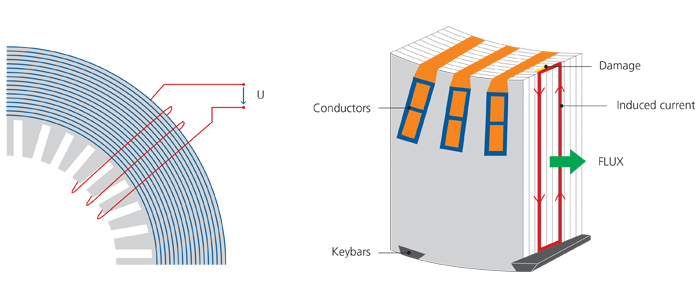- +61 7 3374 2877
- Email Us
The Stator cores of rotating machines are composed of multiple stacked layers to minimise eddy current losses. A short between two or more layers lead to higher local eddy currents. This again can lead to local hot spots which in a worst-case scenario, can cause a partial core melt and eventually the complete damage of the machine.
A ring flux measurement, where the machine is excited at rated flux and the detection of the potential hot spots is performed with a thermographic camera, demands a high amount of power. Furthermore, the setup is both time- and resource-consuming.
The stray flux measurement with the CPC 100 is a reliable alternative, using a portable power source and measurement device that can be energized via an ordinary power plug. Beside the measurement at rated frequency, the CPC 100 allows you to excite the stator core at higher frequencies up to 400 Hz.
The effect of the injection at different frequencies, detection of faults “deeper” in the core as well as the comparison to a ring flux measurement is explained in this article.

To detect weak spots in the insulation of stator core segments, among other methods a stray flux measurement is used. In this case, a small percentage of the rated flux in the range of 2-10% is induced into the core via an auxiliary winding (Figure 1 left side) [1]. If a short between the lamination occurs, a higher eddy current – driven by the induced voltage from the auxiliary windings flux – causes a higher stray flux as shown in Figure 1 on the right side.
This is detected as a higher stray flux by a Chattock or Rogowski coil scanning the stator surface as explained in Figure 2. [3] The readings of the coil are in mA correlated to a certain position within the stator core. As the measurement coil width and the number of turns of the sensor remains the same for each measurement, a calibration can be obtained prior to each measurement.
When measuring at an injection at 4% of rated flux [1], the excitation of the source does not need to deliver typically more than 2-3 kVA [2]. Even lower power is needed in most machines. This represents the major advantage compared with other methods, such as the full flux measurement, as the power supply and the setup for this test are fast and easy.
A common value at which locations should be investigated is 100 mA of the quadrature current, when measurements are performed at 4% of rated flux and rated frequency [1, 2].